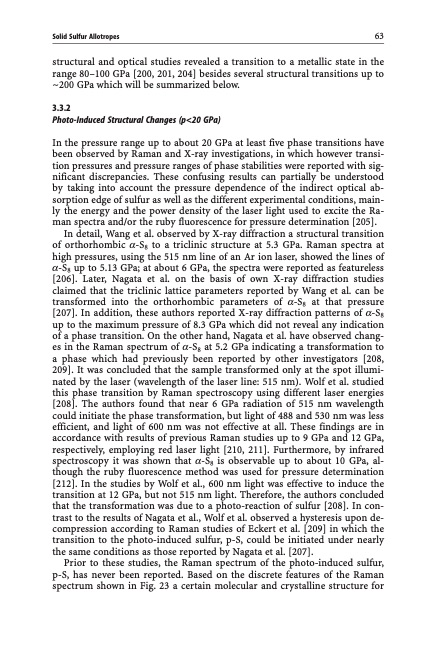
PDF Publication Title:
Text from PDF Page: 073
Solid Sulfur Allotropes 63 structural and optical studies revealed a transition to a metallic state in the range 80–100 GPa [200, 201, 204] besides several structural transitions up to ~200 GPa which will be summarized below. 3.3.2 Photo-Induced Structural Changes (p<20 GPa) In the pressure range up to about 20 GPa at least five phase transitions have been observed by Raman and X-ray investigations, in which however transi- tion pressures and pressure ranges of phase stabilities were reported with sig- nificant discrepancies. These confusing results can partially be understood by taking into account the pressure dependence of the indirect optical ab- sorption edge of sulfur as well as the different experimental conditions, main- ly the energy and the power density of the laser light used to excite the Ra- man spectra and/or the ruby fluorescence for pressure determination [205]. In detail, Wang et al. observed by X-ray diffraction a structural transition of orthorhombic a-S8 to a triclinic structure at 5.3 GPa. Raman spectra at high pressures, using the 515 nm line of an Ar ion laser, showed the lines of a-S8 up to 5.13 GPa; at about 6 GPa, the spectra were reported as featureless [206]. Later, Nagata et al. on the basis of own X-ray diffraction studies claimed that the triclinic lattice parameters reported by Wang et al. can be transformed into the orthorhombic parameters of a-S8 at that pressure [207]. In addition, these authors reported X-ray diffraction patterns of a-S8 up to the maximum pressure of 8.3 GPa which did not reveal any indication of a phase transition. On the other hand, Nagata et al. have observed chang- es in the Raman spectrum of a-S8 at 5.2 GPa indicating a transformation to a phase which had previously been reported by other investigators [208, 209]. It was concluded that the sample transformed only at the spot illumi- nated by the laser (wavelength of the laser line: 515 nm). Wolf et al. studied this phase transition by Raman spectroscopy using different laser energies [208]. The authors found that near 6 GPa radiation of 515 nm wavelength could initiate the phase transformation, but light of 488 and 530 nm was less efficient, and light of 600 nm was not effective at all. These findings are in accordance with results of previous Raman studies up to 9 GPa and 12 GPa, respectively, employing red laser light [210, 211]. Furthermore, by infrared spectroscopy it was shown that a-S8 is observable up to about 10 GPa, al- though the ruby fluorescence method was used for pressure determination [212]. In the studies by Wolf et al., 600 nm light was effective to induce the transition at 12 GPa, but not 515 nm light. Therefore, the authors concluded that the transformation was due to a photo-reaction of sulfur [208]. In con- trast to the results of Nagata et al., Wolf et al. observed a hysteresis upon de- compression according to Raman studies of Eckert et al. [209] in which the transition to the photo-induced sulfur, p-S, could be initiated under nearly the same conditions as those reported by Nagata et al. [207]. Prior to these studies, the Raman spectrum of the photo-induced sulfur, p-S, has never been reported. Based on the discrete features of the Raman spectrum shown in Fig. 23 a certain molecular and crystalline structure forPDF Image | Topics in Current Chemistry

PDF Search Title:
Topics in Current ChemistryOriginal File Name Searched:
Elemental-Sulfur-und-Sulfur-Rich-Compounds-I.pdfDIY PDF Search: Google It | Yahoo | Bing
Sulfur Deposition on Carbon Nanofibers using Supercritical CO2 Sulfur Deposition on Carbon Nanofibers using Supercritical CO2. Gamma sulfur also known as mother of pearl sulfur and nacreous sulfur... More Info
CO2 Organic Rankine Cycle Experimenter Platform The supercritical CO2 phase change system is both a heat pump and organic rankine cycle which can be used for those purposes and as a supercritical extractor for advanced subcritical and supercritical extraction technology. Uses include producing nanoparticles, precious metal CO2 extraction, lithium battery recycling, and other applications... More Info
| CONTACT TEL: 608-238-6001 Email: greg@infinityturbine.com | RSS | AMP |